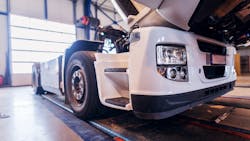Twin steering conversions for commercial vehicles
According to a recent Department for Transport provisional estimates for reported road casualties in the UK, the fatality rate per billion vehicle miles decreased by 6% compared to the year ending in June 2020. While this is welcome news, how can vehicle original equipment manufacturers (OEMs) contribute to even greater safety on our roads? Suraj Jandu, design and development engineer at commercial vehicle steering specialist Pailton Engineering, explains the advantages of twin steering systems for commercial vehicles.
Twin steering conversions are a common requirement for either line marking or road sweeper type applications. For example, Mercedes-Benz Trucks developed the dual control Econic with steering wheels and controls on both sides of the cabin in response to the waste industry’s demand for a version of the truck that best suits side-loading of bins. The driver can easily change their seat without having to alight when starting the waste collection, and therefore always sits on the side that is most convenient for controlling the operation of the automatic garbage collector.
While this technology is by no means new, we are seeing increasing enquires for this type of conversion from the commercial vehicle market. But what is driving this growth?
Increasing visibility
Cycling fatalities are particularly common in busy cities like London, with left turning lorries cited as a leading cause. In January 2022, the Highway Code amendments came into effect to improve the safety of people walking, cycling, and riding horses. These changes focus on road positioning and an updated hierarchy for vulnerable road users. However, there are also conversions that fleet managers can make to commercial vehicles themselves to increase safety.
Transport for London (TfL) research has shown that if commercial vehicle drivers have direct vision through windows, as opposed to looking in cameras or mirrors, this results in a 0.7 second quicker reaction time. This could be the difference between life and death. To increase direct visibility for drivers, direct vision cabs have been developed. The main design changes see the driver seated low in the cab, close to the eye level of pedestrians and cyclists. The cabs also have a large, deep panoramic windscreen with minimal non-glass vertical supports to the left of the cab.
This is an effective design intervention for right-hand drive vehicles operating in the UK, but it doesn’t solve visibility issues for vehicles that must regularly cross borders. Further safety concerns arise from commercial vehicles transporting cargo through different countries and switching between left- and right-hand traffic. A twin steering system allows the driver’s cab position to be changed to suit the environment. With the ability to control the vehicle from either side of the cab, the driver’s visibility can be enhanced, thus increasing both safety and comfort.
However, twin steering conversions need to be carried out and documented by a specialist. Crucially, these systems need to be reliable. Steering systems parts suppliers will be needed to provide bespoke parts, while maintaining the quality of components that are needed to reap the safety benefits of these commercial vehicle conversions.
Information provided by: Pailton Engineering
